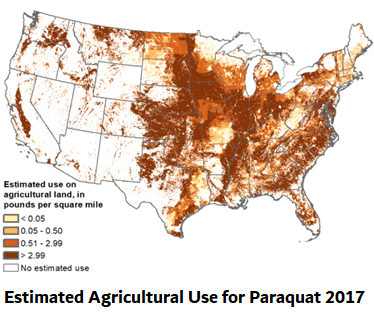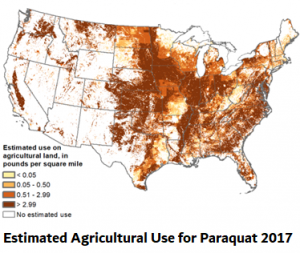 Many Americans first heard of paraquat in the mid 1970s* when it was used to poison marijuana plants. The paraquat-laced cannabis was then sold to unwitting people. Many unlucky smokers inhaled the poison and caused massive damage to their lungs and general health. There was no antidote.
Many Americans first heard of paraquat in the mid 1970s* when it was used to poison marijuana plants. The paraquat-laced cannabis was then sold to unwitting people. Many unlucky smokers inhaled the poison and caused massive damage to their lungs and general health. There was no antidote.Developed in the 1960s, paraquat is a non-selective killer (according to the U.S. EPA), which means that it generally kills any plants with which it comes into contact.
Paraquat’s lethal powers also extend directly to human beings. A single sip of Paraquat can kill a person, while inhalation or skin contact during application can cause seizures, heart failure, and lung scarring.
Dichloride is the active ingredient in paraquat (Gramoxone), which is best known as an herbicide widely used on fields to control the growth of grasses and weeds.
Paraquat and Glyphosate (Roundup) History
Paraquat history shares a dynamic with the history of Monsanto’s glyphosate, which was first registered in the U.S. in 1974. As weeds become more and more resistant to glyphosate (the “active” ingredient listed in Roundup and many other brand name “herbicides”), more and more farmers are turning once again to paraquat. Farmers use it to clear fields of weeds and unwanted plants before planting soybeans. Some also use Paraquat as a desiccant on legume (bean) crops, which causes many non-organic beans to retain significant amounts of the poison. A desiccant is used to dry up fields prior to harvest. Moist or wet plants are less desirable and bring a lower price at market. Consequently, some farmers use herbicides like paraquat to “quick-dry” plants to speed their “ripening” for market.
Paraquat Selling Point
Paraquat’s main advantage over some other popular poisons is that it is inactivated when it comes into contact with soil. Agribusinesses found paraquat’s “soil inactivation” feature to be one of the greatest breakthroughs when it was discovered. Once sprayed on the soil, paraquat kills weeds, but it doesn’t leave biologically active residues. That allows farmers to plant almost immediately after spraying.
1970s Marijuana Killing Fields*
In the 1970s, the U.S. government encouraged the government of Mexico to spray marijuana fields with paraquat. The U.S. State Department knew about the dangers of inhaling, drinking, or skin-contacting paraquat, according to a 1978 New York Times story. The Intercept also reported that paraquat’s maker was examining ways to control the danger in 1976, according to Michael Rose, a scientist at Imperial Chemical Industries (ICI), which was then the manufacturer and marketer of Paraquat.
Paraquat linked to Neurological Diseases
Evidence of an association between paraquat and Parkinson’s disease (PD) first emerged in the 1980s. After the release of studies showing animals and humans exposed to paraquat increased their risk of Parkinson’s disease, Syngenta mounted a defense.
The Intercept reported that documents released in the litigation showed Syngenta had developed a strategy to address issues of neurotoxicity; Syngenta believed it to be a threat to their “business objectives.” Company documents showed Syngenta’s global regulatory manager advised taking steps to “shift the focus of serious PD research to other environmental factors.”
Europe Bans Paraquat
The European Union Court of Justice banned paraquat in 2007. Meanwhile, paraquat use continued to increase in the US, where paraquat poisonings and deaths continued to rise.
Although researchers continue to work on identifying the mechanism through which pesticides impact the neurological system, these chemicals are known neurotoxins that include paraquat, organophosphates, and organochlorine. In addition to immediate effects, long-term, low-dose exposures may also be harmful.
Evidence has suggested that cumulative exposure can also contribute to the development of Alzheimer’s disease. In one animal study, researchers investigated the effects paraquat had on the development of beta-amyloid plaques and changes in cognition. They found an increase in oxidative damage in the mitochondria of the cerebral cortex that directly correlates with impaired learning and memory.
Other animal studies have shown the chemical in paraquat impairs memory, learning, and cognition in offspring when exposed during development. Beyond Pesticides reports mounting evidence which indicates low levels of exposure to pesticides have an adverse effect on the central nervous system, including the development of amyotrophic lateral sclerosis (ALS, also known as Lou Gehrig’s disease), Parkinson’s disease, and dementia-like diseases.
Many of the pesticides share features, including the ability to induce neuronal cell loss, mitochondrial dysfunction, and oxidative stress. Another study used MRI imaging to look at the poison’s effects on humans by focusing on the acute neurotoxic damage caused by paraquat. They found a significant number of abnormal signals in the brains of survivors after the acute toxic phase.
The results demonstrated that paraquat exerted a sustained neurotoxic effect during the acute and recovery stages of poisoning. Another animal study demonstrated that long-term, low-level inhalation of paraquat caused some male mice to lose their sense of smell. The researchers suggest that this data supports the importance of identifying the route of exposure when evaluating neurotoxicity.
RELATED
- Parkinson’s Lawsuit – Paraquat Pesticide | Attorrney
- Paraquat linked to Parkinson’s Disease
- Dow Chemical Pesticide Data Fooled EPA
- Herbicide, Pesticide: What’s the Difference?

by Matthews & Associates




